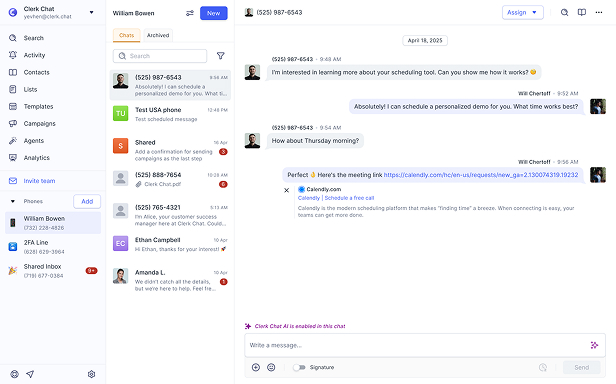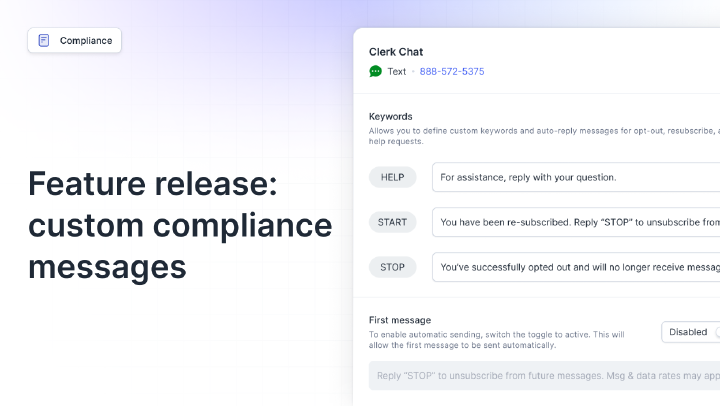SMS opt-out
[ɛs ɛm ɛs ɒpt aʊt]SMS opt-out enables recipients to immediately stop receiving text messages from businesses by replying with keywords like STOP. This fundamental right protects consumer privacy while requiring businesses to maintain compliant suppression systems that process opt-outs instantly and permanently.
Why SMS opt-out matters
The opt-out mechanism represents more than regulatory compliance - it’s the safety valve that maintains trust in business messaging. Without simple, reliable opt-out processes, SMS marketing would collapse under consumer complaints and regulatory crackdowns. The ability to instantly stop unwanted messages gives consumers control, paradoxically making them more willing to opt-in initially.
From a business perspective, proper opt-out handling prevents catastrophic legal exposure. Each message sent after an opt-out request carries potential fines of $500-1,500 under TCPA regulations. A single technical failure that misses 1,000 opt-out requests could result in $1.5 million in penalties from just one follow-up campaign. Major brands have paid hundreds of millions in class-action settlements for opt-out failures.
Yet smart businesses view opt-outs as valuable feedback rather than just compliance overhead. A steady 1-2% opt-out rate indicates healthy list management, while spikes reveal problem areas. Companies using platforms like Clerk Chat to analyze opt-out patterns improve their messaging strategies, reducing overall opt-out rates by 40% while increasing engagement among remaining subscribers. By respecting the unsubscribe decision gracefully, businesses maintain positive brand perception even with departing customers.
How SMS opt-out works
The opt-out process involves automated systems and compliance checkpoints:
Keyword Detection: When recipients reply with opt-out keywords (STOP, UNSUBSCRIBE, CANCEL, END, QUIT), messaging platforms instantly recognize these triggers regardless of capitalization or additional text.
Immediate Processing: Within seconds, the system removes the phone number from all active messaging lists and campaigns, preventing any queued messages from sending.
Suppression List Addition: The opted-out number joins a permanent suppression list that prevents future re-addition through imports, API calls, or manual entry.
Confirmation Message: The system automatically sends a final message confirming the opt-out and explaining how to re-subscribe if desired: “You’ve been unsubscribed from [Business Name]. No more messages will be sent. Reply START to rejoin.”
Cross-List Removal: Advanced systems propagate opt-outs across all business units, preventing situations where customers must opt-out multiple times from different departments.
Compliance Logging: Every opt-out generates detailed logs including timestamp, keyword used, message that triggered opt-out, and confirmation delivery status for audit trails.
Analytics Updates: Opt-out events flow into reporting dashboards, enabling real-time monitoring of trends, campaign performance, and potential compliance issues.
Best practices with SMS opt-out
- Include Clear Instructions in Every Campaign - Add “Reply STOP to unsubscribe” to all promotional messages. For conversational messages, include opt-out instructions at natural intervals, not necessarily every text.
- Process All Reasonable Opt-out Variations - Configure systems to recognize common variations: STOP, STOPALL, UNSUBSCRIBE, CANCEL, END, QUIT, REMOVE, OPTOUT. Include common misspellings and phrases like “stop texting me.”
- Send Immediate Confirmation Messages - Acknowledge opt-outs within 30 seconds with clear confirmation. Include your business name and brief re-subscription instructions. Keep tone respectful and professional.
- Monitor Opt-out Rates by Campaign Type - Track which message types trigger highest opt-outs. If promotional messages show 5% opt-out versus 1% for transactional, adjust frequency and value proposition accordingly.
- Never Attempt to Circumvent Opt-outs - Resist temptation to text from different numbers, use alternative channels immediately, or interpret opt-out requests narrowly. Respect the spirit, not just letter, of the request.
- Implement Global Suppression Lists - Ensure opted-out numbers cannot be re-added through any channel - manual imports, API integrations, or purchased lists. One system failure can trigger massive violations.
- Analyze Exit Patterns for Improvement - Study when customers opt-out (immediately after joining? After specific campaign types?). Use insights to improve targeting, timing, and content relevance for remaining subscribers.
Real world examples
Common misconceptions
Opt-outs must be processed immediately. TCPA requires honoring opt-out requests within minutes, not days or weeks.
While STOP is standard, businesses must honor variations like UNSUBSCRIBE, CANCEL, END, and QUIT as opt-outs.
When customers opt out, you must cease ALL messages including transactional alerts unless they explicitly re-consent.
Free opt-out is legally required. Any attempt to charge or complicate the opt-out process violates FCC regulations.
Related terms
In this article:
Ready to use your business number for text messaging?
Thousands of businesses are already experiencing the power of conversational messaging through SMS. Join us. Free trial and paid tiers available.
Get StartedFAQ
Have questions? We've got answers.
Find what you need quickly and clearly with our most frequently asked questions.
The TCPA mandates that businesses provide clear, free opt-out mechanisms for all SMS programs. Every message must include opt-out instructions or be part of a conversation where opt-out was recently communicated. Businesses must process opt-outs immediately (within minutes), send confirmation of the opt-out, and maintain suppression lists indefinitely. Failure to honor opt-outs can result in $500-1,500 fines per message sent after an opt-out request.
Use SMS platforms like Clerk Chat that automatically detect and process opt-out keywords (STOP, UNSUBSCRIBE, CANCEL, END, QUIT) 24/7. Configure your system to immediately remove opted-out numbers from all lists, send confirmation messages ('You've been unsubscribed. Reply START to rejoin.'), and log opt-out events with timestamps. Test your opt-out flow monthly across different keywords and ensure it works even outside business hours.
Industry benchmarks show 1-3% monthly opt-out rates as healthy for most sectors. Rates below 1% indicate strong message relevance, while above 5% signals problems with frequency, timing, or content quality. E-commerce typically sees 2-3%, healthcare maintains 0.5-1%, while aggressive daily messaging can reach 10%+. Monitor opt-out spikes after specific campaigns to identify problematic messages and adjust strategy accordingly.
Never text customers who opted out unless they explicitly opt back in through a new, documented consent process. You can attempt re-engagement through other channels (email, direct mail, social media) inviting them to rejoin SMS, but cannot send any SMS messages. Some businesses successfully win back 5-10% of opt-outs through email campaigns explaining improved message value or reduced frequency.
While basic opt-out is binary (subscribed or not), sophisticated programs offer preference management. When customers request fewer messages or specific content only, provide options like 'Reply MONTHLY for less frequent messages' or 'Reply SALES to receive only promotional offers.' This flexibility reduces total opt-outs by 30-40% while respecting customer preferences. Always default to full opt-out if requests are unclear.
Monitor opt-out rate trends (daily, weekly, monthly), opt-out sources (which campaigns trigger exits), keyword variations used, time-to-opt-out (how soon after subscribing), and win-back success rates. Analyze opt-out reasons through follow-up surveys via other channels. Set alerts for unusual spikes - a sudden jump from 1% to 5% daily opt-outs indicates serious issues requiring immediate attention.




